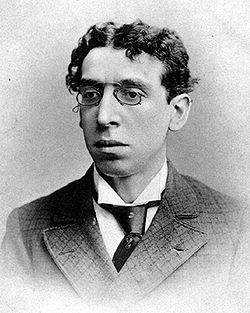Zionist, Head of the Jewish National Fund
1. Menachem Ussishkin was born in Dubrovno in the district of Mogilev, now in Belarus, in August, 1863. The family moved to Moscow in 1871, and he graduated as a technical engineer from Moscow Technical Institute in 1889.
2. While in school he was among the founders of the Society of Pioneers to Eretz Yisrael and active in other Zionist movements. He made his first trip to Palestine in 1891 and wrote a booklet of his impressions. He attended the very first Zionist Congress in 1897 and served as its secretary. At the second Zionist Congress he was elected to the General Council, a position he held for the rest of his life.
 3. He viewed agricultural settlement in Palestine as essential. Purely political Zionism, he felt, might rouse the Turkish authorities against Jews; therefore, he promoted cultural activities and settlement. He went to Palestine for the second time in 1903, following the Kishinev pogrom, and for the third time in 1913. He bitterly opposed the Uganda scheme.
3. He viewed agricultural settlement in Palestine as essential. Purely political Zionism, he felt, might rouse the Turkish authorities against Jews; therefore, he promoted cultural activities and settlement. He went to Palestine for the second time in 1903, following the Kishinev pogrom, and for the third time in 1913. He bitterly opposed the Uganda scheme.
4. In 1919, he made aliyah.
5. He was appointed head of the Zionist Commission in 1920. His pamphlet, “Our Program,” laid out a 5-point plan involving political action, acquisition of land, aliyah, settlement and educational and organizational work. This influenced the Zionist emphasis on agricultural settlements and on educational and cultural institutions, especially the Technion. It gave rise to the Second Aliyah, so that work could be done without help from “hired laborers” [read: Arabs].
6. He was good at negotiation, finding compromise between intransigent opponents: At a clash between orthodox and liberal factions of Hovevei Zion at the Druzkieniki Conference in 1887; at a meeting of settlers with Baron Edward de Rothschild protesting what were considered his paternalistic methods. In 1908, he went to Turkey during the revolution of the Young Turks to try to influence that government in favor of the Jews and Zionism.
7. He was one of the delegates to the Paris Peace Conference at the end of the first world war. On February 17, 1919, he addressed the peace conference in Hebrew.
8. In 1923 he was elected president of the Jewish National Fund. He spearheaded major land acquisitions in the Hefer, Jezreel and Beit She’an valleys. A tireless fundraiser, he increased JNF’s income from 70,000 to 600,000 pounds and its properties from 22,000 to 561,000 dunams. In 1939, when JNF purchased land in the upper Galilee, a series of settlements were founded called Mezodot Ussishkin (Ussishkin Forts). Today, there is a Beit Ussishkin nature museum in Galilee.
9. As early as 1912, he had spoken at Hovevei Zion of the need for a Hebrew University and put through a resolution to allocate 50,000 gold francs for acquisition of land on Mount Scopus. He was there in 1925 at the inauguration of the university and sat on its Board of Trustees and Executive Council.
10. He died in Jerusalem in 1941 at the age of 78. He is buried in Nicanor’s Cave at the botanical gardens of the Hebrew University on Mount Scopus.
Tel Aviv’s Ussishkin Street is found near the old port.











